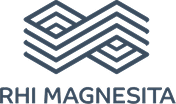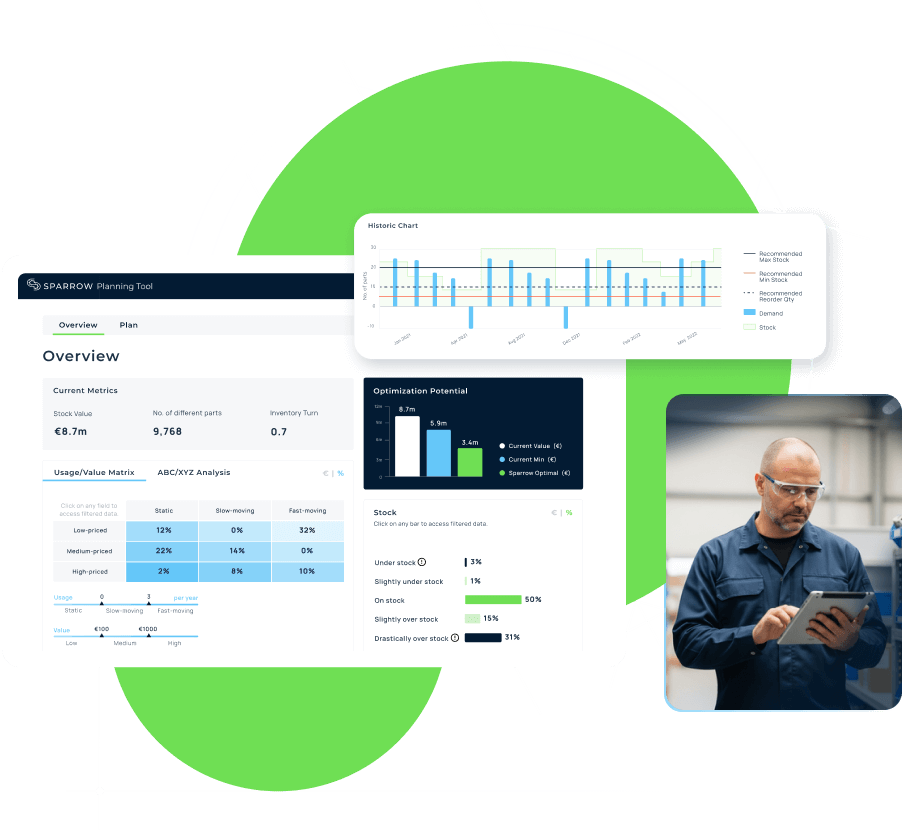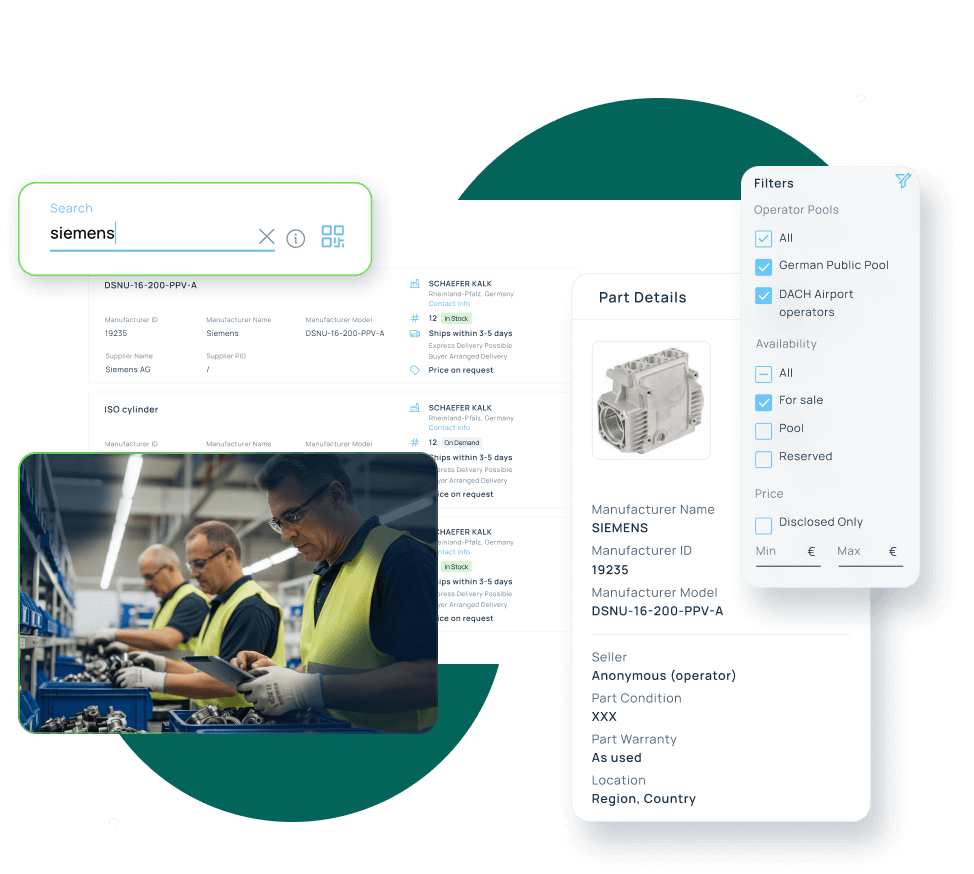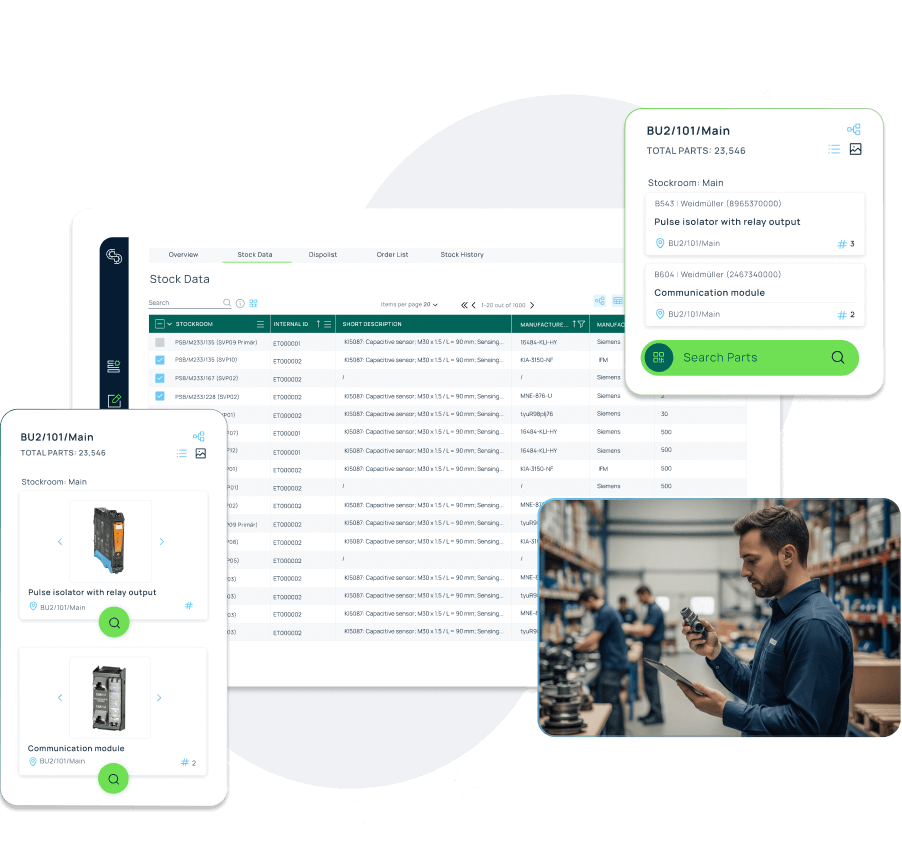Spare part management made simple.
The Hub that turns spare parts into savings: optimise inventory, ensure availability, reduce costs.
Trusted by
















All-in-One, Built for Results
Less Overstock and Waste
Reduce your spare parts stock by eliminating duplicate parts, better planning and pooling.
Higher Availability, less Downtimes
Leverage better planning to reduce risk of stock-outs. Tap a large pool of spare parts in emergencies.
Eliminate Manual Effort
Cut spare parts management overhead: maintain data quality, plan, search, and procure with ease.
Complete visibility over spare parts
All the metrics and information you need to make informed decisions about your spare parts in one powerful dashboard.

One Hub. Complete Lifecycle Control.
- Manage the full lifecycle of your spare parts: from sourcing to standardisation, inventory, and storage
- Centralise data to make faster, smarter decisions
- Improve efficiency across sites, teams, and suppliers
- Roll out modularly — start where the impact is greatest and scale across functions and sites over time
.png)
AI-powered data cleaning solution
- Reduce duplicates in your spare parts stock
- Identify obsolete parts
- Improve procurement processes
- Reduce search time for maintenance teams

Custom spare parts planning and optimisation
- Reduce overstock using dynamic planning
- Improve uptime with accurate demand forecasting
- Keep up-to-date with supply chain intelligence
- View key spare parts metrics at a glance

Network of operators and suppliers for critical spares
- Create an internal pool for sharing parts
- Tap an unlimited pool of spare parts in emergencies
- Find more suppliers for your parts
- Sell overstocked spare parts

Simple-to-use spare parts inventory manager
- Locate spare parts with a user-friendly interface
- Standardise stock data and streamline item management
- Gain real-time visibility into inventory levels and locations
- Reduce time spent searching, sorting, and replenishing parts


Value Delivered, Team by Team
- No more spreadsheets, silos, or guesswork — just smarter decisions made simple.
- One Source of Truth for Maintenance, Procurement, Plant, and IT.

For Maintenance Managers: Plan, Prioritise, Prevent
- Prioritise what’s critical with criticality scoring and visual alerts
- Predict obsolescence and track usage to prevent surprises
- Avoid overstocking and shortages with better planning
- Align with procurement through a shared, data-driven view

For Plant Managers:
Stay on Budget, Stay in Control
- Full visibility into MRO spend
- Forecast spare parts needs with confidence
- Control costs through standardised pricing
- Spot budget risks with real-time insights

For Procurement Managers: Better visibility, smarter sourcing
- Improve data quality and save time on specs and approvals
- Identify bundling opportunities and streamline sourcing
- Find alternative sourcing options, incl. internal transfers
- Align easily with maintenance and engineering teams

For IT Managers:
Clean Data, Seamless Integration
- Clean and harmonise spare parts data with minimal rework
- Add intelligence before and after your ERP migration
- Identify and fix data quality issues with actionable insights
- Integrate effortlessly into your existing IT architecture

For Spare Parts Suppliers:
Connect, Share, Grow
- Reach qualified buyers through a trusted industry network
- Improve procurement process for existing customers
- Share real-time product, pricing, and availability data
- Secure recurring revenue from your stock

Ready to streamline your spare parts strategy?

Spare parts management can quickly turn into a headache, especially if your organisation is running multiple sites. Data is often scattered across systems, spare parts naming conventions vary, and duplicate spare parts pile up. Add to that poor visibility into stock levels or the criticality of a spare part, and the result is predictable: overstocks, emergency orders, rising costs, and lower service quality. Even leading manufacturers face these issues. Without a clear approach to spare parts management, it’s hard to optimise working capital, reduce risk, or make confident decisions that keep operations running smoothly.
Why do spare parts optimisation matters?
Because downtime is costly — sometimes even unacceptable — in industries like pharma, automotive, or food and beverage. It’s about making sure the right part is available when it’s needed, without tying up money in shelves full of obsolete or duplicate items. By optimising spare parts, manufacturers strike the balance between availability and cost. It also brings procurement and maintenance teams closer together, helping them plan ahead, cut down on express orders, and build a more resilient, efficient MRO setup.
Why is it hard to keep track of spare parts across multiple plants?
In large manufacturing groups, spare parts data often lives in silos. Different ERPs, plants, and teams use their own naming conventions, part numbers, or classifications. The result? Duplicate parts, fragmented inventories, and no clear overview at group level. This makes it difficult to pool stock, reduce costs, or keep control of MRO spend. Without one source of truth, central teams are left managing complexity without real visibility. That’s exactly what the SPARROW Hub solves: it brings all spare parts data together into a single, reliable view across your network. (You can read more about cross-site strategies on our blog.)
Which industries benefit the most from smart inventory planning?
Any industry that relies on critical equipment and high production uptime gains from smarter inventory optimisation. For sectors like pharmaceuticals, food & beverage, and automotive, it’s even more crucial. Here, compliance, reliability, and traceability aren’t optional — they’re business-critical. Poorly optimised inventories drive up costs, increase operational risk, and slow down response times. By improving their spare parts data and processes, these industries can strengthen resilience, ensure smoother operations, and move towards more sustainable performance in both maintenance and supply chain strategies.
ERP software is essential for running core business processes, but it wasn’t built with spare parts management in mind. SPARROW fills that gap. It doesn’t replace your ERP — it enhances it with an intelligence layer focused on data quality, criticality-based decision-making, and collaboration between maintenance, procurement, and IT.
SPARROW stands out through its modern user experience: it’s intuitive, visual, and tailored for operational users — not just data experts or IT teams. Maintenance leads, plant managers, and buyers can easily navigate the platform, interpret criticality scores, and act on insights without training or technical support. Instead of combing through spreadsheets or ERP tables, teams work with interactive dashboards, smart filters, and guided workflows that make spare parts management easier and more effective.
On top of that, SPARROW’s intuitive UX makes it easy to keep data and inventories clean and up to date. Its mobile-friendly design means teams can use it directly on the shop floor, making daily work faster and simpler. The result? Quick adoption, measurable impact in weeks, and a solution that scales without the pain of a full IT transformation.
Is SPARROW relevant for companies undergoing an ERP transformation?
Indeed! Many manufacturers use the SPARROW Hub as a preparatory step before migrating to SAP S/4HANA or consolidating their ERP landscape. Harmonised spare parts data is a foundational requirement for any successful transformation. By using SPARROW to clean, standardise, and align MRO data in advance, companies can avoid costly delays, reduce migration complexity, and improve the quality of their new system from day one. SPARROW acts as both a short-term accelerator and a long-term governance layer for ERP and CMMS environments.
And why is SPARROW a better fit for our spare parts data than a CMMS?
A CMMS is designed to plan and track maintenance tasks — not to solve the complex challenges of spare parts data. That’s where SPARROW makes the difference. It acts as the intelligence layer on top of your existing systems, cleaning and harmonising spare parts data, eliminating duplicates, and giving you full visibility across sites. Importantly, SPARROW is fully mobile-friendly, making it accessible on tablets or smartphones directly from the shop floor. Whether you’re walking through the plant or reviewing inventory on-site, your team can access real-time insights and make data-driven decisions without being tied to a desk. Instead of replacing your CMMS, SPARROW complements it — ensuring maintenance schedules run on reliable, high-quality spare parts data.
Most clients see real impact within just a few weeks. SPARROW delivers cleaner, more usable spare parts data, faster decisions on critical items, and stronger collaboration across departments. Early wins often include duplicate parts reduction, fewer emergency orders, and greater confidence in day-to-day decisions. Over time, SPARROW enables reduced inventory through optimised planning, lower MRO costs, and higher stock availability for essential parts. Clients also benefit from stronger governance, improved ERP data quality, and better alignment between maintenance and procurement. The results are measurable, scalable, and fully in line with your operational KPIs. To calculate your own ROI, feel free to use our ROI calculator.
How does the SPARROW Hub simplify spare parts management across the entire enterprise?
The SPARROW Hub turns spare parts management into a collaborative effort across the entire network. Central teams can define data standards, rules, and governance in one place (like criticality or stock policies), while local sites keep the flexibility they need for daily operations. With one shared view, plants can spot duplicate parts, share stock, and optimise MRO procurement by pooling demand across locations and bundling orders. A leading Pharma company, Bayer, for example, began with a few isolated sites and is now rolling out the SPARROW Hub globally — a move that makes perfect sense ahead of their SAP S/4HANA transition. The result: smoother collaboration, lower costs, and smarter, future-proof decisions across the group.
Who uses the SPARROW Hub within organisations?
The SPARROW Hub is used by Materials Managers, Procurement Managers, Spare Parts Managers, different spare parts data stakeholders and— anyone responsible for multi-site coordination or ERP strategy. At the plant level, maintenance and supply chain managers also interact with the Hub to align their operations with corporate standards. Each role gets a tailored experience with dashboards, filters, and tools relevant to their function — making SPARROW a true enabler of cross-functional collaboration in spare parts management.
You can get SPARROW up and running in just 30 days. The onboarding is designed to be light-touch, with minimal disruption to your teams. There’s no need for upfront IT integration — we work directly with your real spare parts data to deliver value quickly. Our team guides you step by step through setup, cleansing, and analysis, helping maintenance, procurement, and IT align from day one. Within weeks, companies see cleaner data, sharper insights, and measurable impact. This fast time-to-value is one of the main reasons manufacturers choose SPARROW to drive their MRO transformation.
Can the SPARROW Hub connect data from different ERPs or CMMS platforms?
The SPARROW Hub is built to handle spare parts data from multiple sources and systems. Whether your plants use different ERP instances, legacy CMMS tools, or local spreadsheets, SPARROW can ingest and standardise the data for cross-site analysis. This is a key advantage for manufacturers with decentralised IT landscapes, allowing them to get a unified view of their MRO landscape without waiting for a full system consolidation.
What data do we need to get started?
All we need to begin is your spare parts master data and inventory exports — standard files your team usually already has in your ERP. There’s no need for heavy technical prep or manual cleansing upfront. SPARROW’s tools are built to handle messy, inconsistent MRO data and clean it along the way. And even if your data isn’t yet in your ERP, that’s not a barrier: one of our clients started by taking photos of 55,000 spare parts reference tags, which we then matched against our database to create a complete spare parts catalogue. It’s a fast, practical way to bring order to your spare parts management and reveal data quality issues that might be holding you back today.
Do we need to integrate SPARROW with our ERP?
We don't need to integrate SPARROW with your ERP to begin with. SPARROW is designed to work alongside your existing ERP, CMMS, or procurement systems — whether you're using SAP, Oracle, Maximo, or other tools. It acts as an intelligent overlay that connects with your data but doesn’t interfere with your core processes. You can start using SPARROW as a standalone platform, and choose to integrate once your teams are confident in the outcomes. This flexibility reduces implementation friction and lets you focus on results rather than technical constraints.
Do we need to start with SPARROW.Clean?
SPARROW is designed to be modular and flexible — you can start with any solution that best fits your current priorities. While many clients begin with SPARROW.Clean to address data quality and duplicate parts, it's just as effective to start with other modules such as SPARROW.Plan for criticality-based planning, SPARROW.Stock for inventory right-sizing, or SPARROW.Pool to unlock collaboration between plants.
Each module delivers value on its own, but they also integrate seamlessly as part of a broader spare parts management strategy. This means you can begin where the pain is most urgent, demonstrate quick wins, and then scale to other areas over time — all without reimplementing or disrupting your existing systems. Whether you're focused on improving visibility, reducing MRO costs, or preparing for an ERP transformation, SPARROW adapts to your roadmap, not the other way around.
Yes — SPARROW is fully GDPR-compliant and meets enterprise-grade security standards. Your data is stored securely in Frankfurt / Germany, with options for cloud hosting or hybrid deployment. We follow best practices in encryption, access control, and data handling to ensure your information stays protected and under your control. Our team also supports IT and security reviews during onboarding, so you can be confident all compliance requirements are met before your teams start using the platform.







